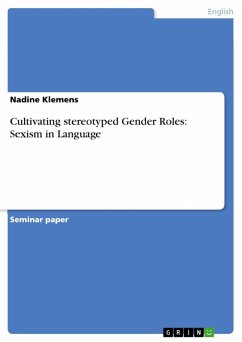Seminar paper from the year 2002 in the subject English Language and Literature Studies - Linguistics, grade: 2+ (B), Technical University of Braunschweig (English Seminar), language: English, abstract: Women are more emotional than men, they speak in a different way than men, but how are they spoken about? Throughout the last century there has been a lot of discussion concerning language and gender. Mainly, linguists have focused on the different discourse strategies and conversational styles of women and men, that is, they dealt with the difference of women's and men's language. Sexism became an important point of discussion in the 1960s, and especially feminist critiques have discussed the sexist representation of women in language. Many linguists tried to find alternatives for features of language that discriminate against women, and thus sought to correct existing sex biases. In a time where the inequality of the sexes is said to have diminished, the anti-sexism movement seems to have decreased, as well. People try to speak in a politically correct way, a way that is not sexist or racist, but certain stereotypes are nevertheless still part of the language system. This can be seen when taking a closer look at the media, which plays an important role in the process of language development. Newspapers articles, for example, have to be objective and without bias, but as they employ language that is politically correct with regard to common language usage, they reflect the language of a society. Consequently, the media is a rich source for analysis when it comes to examining to what extent sexism is still an issue today. Has the feminist fight against male supremacy been without effect? The author discusses if sexism in language has diminished and how it is dealt with. Therefore, sexist language is defined and the relationship to society with the help of several linguistic approaches. As part of this, the different features of sexist language, such as derogatory designations for women, the generic masculine, feminine markers, and the problem of personal titles are explained. Furthermore, the role of the media in context with sexist language is depicted and is put in relation to sexism in newspapers, by listing some rules established by the Associated Press that intend to help journalists deal with sexist features of language. Finally, articles from The Washington Post are analyzed to examine if sexist language is still perpetuated.
Dieser Download kann aus rechtlichen Gründen nur mit Rechnungsadresse in A, B, BG, CY, CZ, D, DK, EW, E, FIN, F, GR, HR, H, IRL, I, LT, L, LR, M, NL, PL, P, R, S, SLO, SK ausgeliefert werden.









